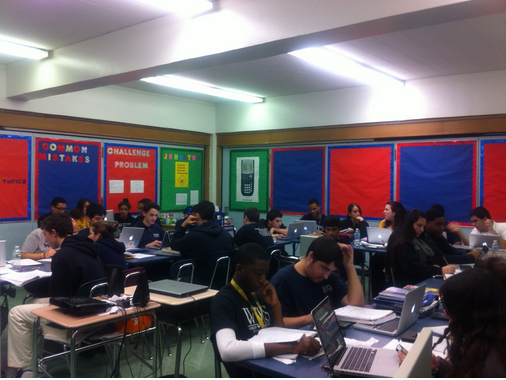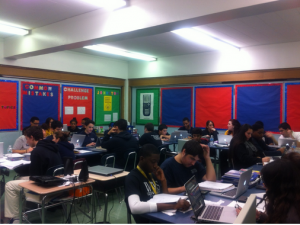Education in the 21st Century

Students in geometry use computers to do their project. This is a great way to gather resources, plan and draft. Photo by Alice Mungyu.
by Alice Mungyu, co-feature editor

Back in the day, students would use textbooks to read and learn. But that’s not the case in today’s tech-savvy culture. Changes in learning has evolved drastically and the increase in complexity has presented new challenges and put more demands on the education system.
In the 21st century, technology has changed the ways in which students communicate and go about their lives. Social media such as Blogger, Twitter, Facebook, and other online platforms allows students and teachers to reach out to a broader notion of audience.
Interactive Presentations
Students no longer need to hold poster boards because web tools such as Glogster, Prezi, and others have changed this experience. Glogster is a platform where presenters can create a multimedia “glog” or poster to demonstrate what they know and learned about a topic. Prezi is a cloud-based presentation software and storytelling tool for presenting ideas on a virtual canvas.
“Instead of powerpoint slides, Prezi is a more entertaining way to get my ideas across. I can pan and zoom in to emphasize a point,” sophomore Melissa Chen said.
Ebooks vs. Print Copies
E-reading devices have been around only a few years, but it’s already taking over classrooms. Cheaper and lighter, students can just pull up their tablet or kindle ebooks to open up the file.
“It’s more interactive, and my son definitely enjoys using a tablet to read rather than holding a book. He love how he can zoom into words and define them on the spot,” mother Christine Jolie said.
Digital Learning
Colleges, organizations, and companies are now in the process of developing applications that will enable users to earn a degree or certification through online courses. These programs can be run on an iPad, tablet, or computer which can be very useful for those who can’t attend classes held in universities.
“Learning online can definitely save me a lot of time, especially because I have two children to take care of. I can finally learn on my own time without having to worry about paying $20,000 for a semester at my university,” college student Michelle Adams said.
Although education in the 21st century is rapidly changing, technology is a huge factor and will only continue to advance.
